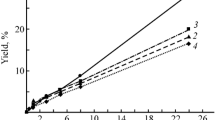Summary
An investigation was carried out on drag reduction of diluted solutions of four polyisobutylenes of different molecular weight in diversely good and poor solvents in the turbulent region at small (up to 5000) and average (from 19 000 to 42 000) Reynolds numbers, as well as of mixtures of polyisobutylene and polystyrene and of two polyisobutylenes of different molecular weight. Concentration at maximum drag reduction grows, while drag reduction itself decreases with molecular weight going down. The universal curve established byVirk et al. for aqueous solutions of a polyethylene oxide family is also confirmed for a family of polyisobutylenes in an organic solvent. The effect of polymer coils of various dimensions on drag reduction is assessed. PIB coils of various dimensions are produced in two ways — dissolving polyisobutylenes of different molecular weight in a given solvent and dissolving polyisobutylene of a definite molecular weight in diversely good and poor solvent. Coil dimensions in the solution are increasing with the growth of intrinsic viscosity of a polymer by dissolving it in still better solvents, but probably due to impeded orientation and deformation of the larger polymer coils their drag reduction is smaller at low rather than at high shear stresses. Drag reduction of diluted solutions of two PIB differing in molecular weight shows almost no deviation from the additive straight line both when the overall concentration of solutions is equal and when it exceeds the one at maximum drag reduction of PIB of higher molecular weight. Drag reduction of diluted solutions of PIB and PS mixtures at an overall concentration higher than optimum concentration shows a positive deviation from the additive straight line.
Zusammenfassung
Untersucht wurde die Verringerung des Reibungswiderstandes (VRW) fließender, verdünnter Lösungen von vier Polyisobutylenen mit verschiedenem Molekulargewicht in unterschiedlich guten und schlechten Lösungsmitteln im turbulenten Bereich bei kleinen (bis 5000) und bei mittleren (von 19 000 bis 42 000) Reynoldsschen Zahlen, sowie von Mischungen aus Polyisobutylen und Polystyrol und aus zwei Polyisobutylenen mit verschiedenem Molekulargewicht. Die Konzentration bei maximalem VRW-Effekt nimmt zu, und der maximale VRW-Effekt selbst vermindert sich mit abnehmendem Molekulargewicht. Die vonVirk und Mitarbeitern für wäßrige Lösungen einer Reihe von Polyäthylenen festgestellte universale Kurve wird auch für die Polyisobutylenfamilie in einem organischen Lösungsmittel bestätigt. Der Einfluß der nach ihren Dimensionen unterschiedlichen Polymerknäuel auf die Verringerung des Reibungswiderstandes wurde ausgewertet. Polyisobutylen-Knäuel mit verschiedenen Dimensionen werden auf zwei Weisen realisiert, durch Auflösung von Polyisobutylenen mit verschiedenem Molekulargewicht in einem gegebenen Lösungsmittel und durch Auflösung von Polyisobutylen mit einem gegebenen Molekulargewicht in unterschiedlich guten und schlechten Lösungsmitteln. Mit der durch seine Auflösung in immer besseren Lösungsmitteln steigenden Grenzviskosität eines Polymeren nehmen die Knäueldimensionen in den Lösungen zu. Jedoch ist, wahrscheinlich wegen der damit verbundenen Behinderung der Orientierung und Deformierung der größeren Polymerknäuel, ihr VRW-Effekt bei den niedrigen Scherspannungen kleiner als bei den höheren. Der VRW-Effekt der verdünnten Lösungen aus zwei Polyisobutylenen mit verschiedenem Molekulargewicht weist fast keine Abweichung von der additiven Geraden auf, sowohl wenn die Gesamtkonzentration der Lösungen gleich als auch wenn sie größer als die Konzentration beim maximalen VRW-Effekt des Polyisobutylens mit höherem Molekulargewicht ist. Der VRW-Effekt der verdünnten Lösungen von Mischungen aus Polyisobutylen und Polystyrol mit einer über der optimalen liegenden Gesamtkonzentration zeigt eine positive Abweichung von der additiven Geraden.
Similar content being viewed by others
Abbreviations
- D :
-
diameter of capillary
- [DR]:
-
intrinsic drag reduction
- DR F :
-
fractional drag reduction
- DR F, max :
-
maximum fractional drag reduction
- DRsp :
-
specific drag reduction
- K :
-
constant
- L :
-
length of capillary
- M v :
-
molecular weight of polymer, determined by the viscosimetric method
- \(\dot V\) :
-
flow rate
- c :
-
concentration
- [c]:
-
intrinsic concentration
- ρ equiv. :
-
equivalent sphere density
- τ w, p :
-
wall shear stress of polymer solution
- τ w, s :
-
wall shear stress of solvent
- CMC:
-
carboxymethylcellulose
- PAA:
-
polyacrylamide
- PEO:
-
polyethylene oxide
- PIB:
-
polyisobutylene
- PS:
-
polystyrene
- DR:
-
drag reduction
References
Ting, R. Y., O. K. Kim Amer. Chem. Soc., Div. Org. Coatings Plast. Chem. Pap.32, 270 (1972).
Dschagarowa, E., G. Mennig, Fortschr.-Ber. VDI-Z. Reihe 7/41 (1976).
Hoyt, J. W. J. Polymer Sci.B9, 851 (1971).
Lee, T. S., Proc. (Fifth) Intern. Congr. on Rheology, Vol. 4 (Tokyo 1970).
Fisher, D. H., F. Rodriguez J. Appl. Polymer Sci.15, 2975 (1971).
Chashchin, I. P., Y. N. Suhutin, N. T. Shalavin Collection of works of young scientists from the higher technical educational institutions, Tomsk (USSR)1, 221 (1973).
Chashchin, I. P., N. T. Shalavin, V. A. Saenko Communications of the higher educational institutions in USSR, Chemistry and Chemical Technology17, 602 (1974).
Chashchin, I. P., N. T. Shalavin, V. A. Saenko Collection of works of young scientists from the higher technical educational institutions, Tomsk (USSR)1, 218 (1973).
Dschagarowa, E., G. Mennig Rheol. Acta14, 1089 (1975).
Virk, P. S., E. W. Merrill, H. S. Mickley, K. A. Smith, E. L. Mollo-Christensen J. Fluid Mech.30, 305 (1967).
Schurz, J., Einführung in die Struktur-Rheologie (Stuttgart 1974).
Morawetz, H., Macromolecules in Solution (New York 1965).
Vollmert, B., Grundriß der makromolekularen Chemie (Berlin 1962).
Hershey, H. C., J. L. Zakin Ind. Eng. Chem. Fundam.6, 381 (1967).
Peyser, P., R. C. Little J. Appl. Polymer Sci.15, 2623 (1971).
Little, R. C., R. L. Patterson J. Appl. Polymer Sci.18, 1529 (1974).
Kuleznev, V. N., L. S. Krohina Advances of Chemistry (Uspehi Chimii),7, 1278 (1973).
Kuleznev, V. N., L. S. Krohina Vysokomol. soed.A 15, 906 (1973).
Dinglian, G., E. Ruckenstein AIChE Journal20, 1222 (1974).
Author information
Authors and Affiliations
Additional information
With 8 figures and 2 tables
Rights and permissions
About this article
Cite this article
Dschagarowa, E., Mennig, G. Influence of molecular weight and molecular conformation of polymers on turbulent drag reduction. Rheol Acta 16, 309–316 (1977). https://doi.org/10.1007/BF01523741
Received:
Issue Date:
DOI: https://doi.org/10.1007/BF01523741




